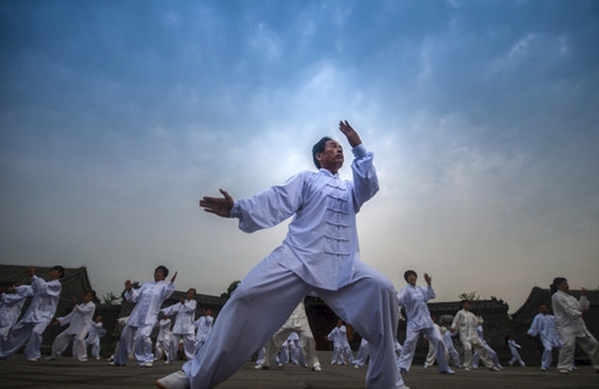Bringing kung fu into the modern era
Author : Xia Tian Source : Chinese Social Sciences Today 2016-08-30

A group demonstrates taijiquan at a square in Henan Province. Taijiquan, a kind of traditional Chinese shadowboxing, is the most popular form of Chinese boxing. The core of taijiquan carries the mission of spreading a harmonious culture. In 2006, taijiquan was included in the national intangible cultural heritage list.
Kung fu is one of China’s most high-profile cultural exports and is closely connected with China’s martial and sports history. Action films starring Bruce Lee once captivated the world, and to this day, Chinese martial arts directors and choreographers have earned a special place in Hollywood.China’s martial arts chivalry culture, an intrinsic part of wuxia fantasy kung fu culture, has also made its mark around the world.
However, as is the case with other intangible aspects of cultural heritage, the development of martial arts in modern and contemporary China has suffered many challenges.
During the first Opium War (1840-1842), kung fu was not able to stand against Western military forces, which easily defeated the Qing Dynasty.
In today’s many international sports competition events, such as the Olympic Games, Chinese kung fu lacks a presence, and many doubt its viability as a national sport.
In regard to kung fu’s absence from the Olympics, Chinese scholars point to differences about what competition entails.
The fact these differences exist does not diminish the importance of kung fu. Kung Fu is a martial art with strong traditional cultural significance, and it embodies many aspects of Chinese culture.
It goes hand in hand with traditional Chinese medicines as it is part of the yin-yang philosophy. It is also integrated with moral, ethical and religious customs. It has also shaped a generation’s view of fantasy and action films, shaping a number of images of China from within the country and outside.
Passing down kung fu culture to the next generation is crucial to contemporary China.
The traditional methods of passing culture down through generations, such as the master-disciple teaching method, have resulted in an imbalanced ratio between masters and disciples—one master with too few disciples—which has restricted the growth of the martial art.
Kung fu has a strict hierarchy between masters and disciples. Taking someone as a master is a sacred ceremony for disciples. For many schools of martial arts, one master only teaches a few disciples throughout his whole life. So it is very difficult to promote each school of kung fu.
A form of Chinese boxing can evolve into various schools, but this can result in disputes between them. For instance, taijiquan, a kind of traditional Chinese shadowboxing, is the most popular form of Chinese boxing. But there are also intense disputes among the various schools of shadowboxing. The core of taijiquan carries the mission of spreading a harmonious culture. So stopping the fights among the schools and learning from each other should be a priority.
It takes a very long time to train in a martial art. A lot of this martial knowledge doesn’t come from theories and can only be understood through insight and experience. In terms of individual learners, this teaching method cannot guarantee any results. So modern teaching measures should be introduced to martial arts, such as multimedia presentations and scientific data, enabling both masters and disciples to interact in more positive ways and deepen their understanding.
In China, 130 schools of traditional martial arts have been officially recognized. All resources among these schools should be combined to fully promote their transformation into modern sports competitive clubs and organize a national tournament for martial arts. Now, more than a hundred of competitive clubs in the name of their schools have been established. They are bringing about the rules of fighting competitions and attempting to facilitate the professionalism of traditional masters, promoting kung fu’s transformation into a modern sports industry.
Ye Shengtao made Chinese fairy tales from a wilderness
Ye Shengtao (1894–1988) created the first collection of fairy tales in the history of Chinese children’s literature...
-
How northern ethnicities integrated into Chinese nation
2023-09-18
-
Mogao caves
2023-09-12
-
Mogao Grottoes as ‘a place of pilgrimage’
2023-09-12
-
Time-honored architectural traditions in China
2023-08-29
-
Disentangling the civilizational evolution of China
2023-08-28
-
AI ethics in science fiction
2023-08-23














 2011-2013 by www.cssn.cn. All Rights Reserved
2011-2013 by www.cssn.cn. All Rights Reserved